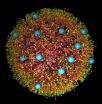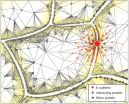Colorful nano-guides to the liver
A research team of the University of Jena, Germany, produces highly specific nanoparticles
2014-12-03
(Press-News.org) This news release is available in German.
(Jena/Germany) Jena scientists have been successful in producing highly specific nanoparticles. Depending on the bound dye the particles are guided to the liver or to the kidney and deliver their payload of active ingredients directly to the targeted tissue. Moreover, the dyes enable the tracking of the transport processes by intravital microscopy or, in a non-invasive way, by multi spectral optoacoustic tomography. The reduction of cholesterol production induced by siRNA served as the proof-of-principle for the developed method. The scientists report their data in the new edition of the scientific journal "Nature Communications".
They are one of the great hopes for target-oriented treatment approaches: the so-called small interfering RNA-molecules, siRNA. These are able to mute specific genes, by preventing them from producing proteins which are encoded on them. To accomplish this, the siRNA has to be delivered specifically into the targeted cells in order to work only there and nowhere else. Moreover, the siRNA should not be just excreted or, even worse, damage healthy tissue. This is what makes the handling of siRNA extremely difficult. Physicians and chemists from Jena, Munich (both Germany) and the USA have now succeeded in producing nano-transporters for this genetic material which are able to specifically and efficiently target selected cell types and release their active payload there.
Fluorescent dyes are both address labels and tracking numbers all in one
The particles which are based on polymers are marked with near infrared fluorescent dyes and loaded with siRNA. The dyes work like address labels and tracking numbers for the particles all in one. "Depending on the chemical structure of the dye the particles are filtered out of the blood either via the kidney tissue or via liver cells. At the same time this route can easily be tracked by optical methods with the aid of the dyes," describes intensive care physician Prof. Dr. Michael Bauer. His research team at the Jena University Hospital Centre for Sepsis Control and Care (CSCC), which is supported by the Federal Ministry of Education and Research, was also able to show that the dye is specifically absorbed by a specific cellular transporter of the liver epithelial cells and taken up into the cells.
Toolbox for nanomedicine
In this way the siRNA load is exclusively released in the target cells. The specifically functionalized nano-containers have been designed and produced in the laboratories of the Jena Center for Soft Matter (JCSM) of the Friedrich Schiller University in Jena. "This method can be regarded as a kind of toolbox for a multitude of different siRNA-nanotransporters which can ensure the targeted ,switch-off' of specific protein biosynthesis in different cell types," the Director of the JCSM, Prof. Dr. Ulrich S. Schubert, states. With the possibility to test the non-coupled dyes in advance and to switch off genes which are associated with illnesses, the principle offers new approaches to a personalized therapy of various diseases. In the newly founded SmartDyeLivery GmbH, the Jena scientists want to further develop the technology to put it into practical use in the clinical environment, especially in cases of acute septic infections.
The Jena nanomedicine researchers explain in their study the working principle of their toolbox using the example of cholesterol production. They loaded the nanoparticles with targeting dyes attached with siRNA-molecules. The siRNA molecules interfered with cholesterol production in hepatocytes, which resulted a clear reduction in the cholesterol level in the blood of test animals. The study is now published in the scientific journal "Nature Communications".
INFORMATION:
Original-Publication:
A. T. Press, A. Traeger, C. Pietsch, A. Mosig, M. Wagner, M. G. Clemens, N. Jbeily, N. Koch, M. Gottschaldt, N. Bézière, V. Ermolayev, V. Ntziachristos, J. Popp, M. Kessels, B. Qualmann, U. S. Schubert, M. Bauer: "Cell type-specific delivery of short interfering RNAs by dye-functionalized "theranostic" nanoparticles", Nat. Commun. 2014, DOI: 10.1038/ncomms6565
Contact:
Prof. Dr. Michael Bauer
Center for Sepsis Control and Care (CSCC), Jena University Hospital
Phone: +0049 (0)3641 9323111
Email: Michael.Bauer[at]med.uni-jena.de
Prof. Dr. Ulrich S. Schubert
Jena Center for Soft Matter (JCSM), Friedrich Schiller University in Jena
Phone: +0049 (0)3641 948200
Email: Ulrich.Schubert[at]uni-jena.de
[Attachments] See images for this press release:

ELSE PRESS RELEASES FROM THIS DATE:
2014-12-03
What do lasers, neural networks, and spreading epidemics have in common? They share a most basic feature whereby an initial pulse can propagate through a medium - be it physical, biological or socio-economic, respectively. The challenge is to gain a better understanding - and eventually control - of such systems, allowing them to be applied, for instance to real neural systems. This is the objective of a new theoretical study published in EPJ B by Clemens Bachmair and Eckehard Schöll from the Berlin University of Technology in Germany. Ultimately, with a better theoretical ...
2014-12-03
New research from the University of Adelaide has helped to shed light on the complexities of child sleep, and could lead to improved diagnosis of children with sleep-related breathing problems.
For his PhD in the University's School of Medical Sciences, Scott Coussens has been investigating how to accurately measure the level of sleep disturbance being experienced by children, to show whether or not they require treatment.
"Quality sleep is extremely important for children, especially at critical times of development. It can impact on the health of the brain and plays ...
2014-12-03
New Rochelle, NY, December 3, 2014--Are adolescents who view pornography or music videos more likely to engage in sexting, in which they share sexually explicit content via text, photo, or video using cell phones, email, or social networking sites? A study of the media consumption and sexting behavior of more than 300 teens is published in Cyberpsychology, Behavior, and Social Networking, a peer-reviewed journal from Mary Ann Liebert, Inc., publishers. The article is available free on the Cyberpsychology, Behavior, and Social Networking website.
In "The Associations ...
2014-12-03
Plastic waste is one of today's major environmental concerns. Most types of plastic do not biodegrade but break up into ever smaller pieces while remaining a polymer. Also, most types are made from oil, a rapidly dwindling resource. But there are promising alternatives, and one of them is polylactic acid (PLA): it is biodegradable and made from renewable resources. Manufacturers use PLA for disposable cups, bags and other sorts of packaging. The demand for PLA is constantly rising and has been estimated to reach about one megaton per year by 2020.
The research groups ...
2014-12-03
Planets orbiting close to low-mass stars -- easily the most common stars in the universe -- are prime targets in the search for extraterrestrial life.
But new research led by an astronomy graduate student at the University of Washington indicates some such planets may have long since lost their chance at hosting life because of intense heat during their formative years.
Low-mass stars, also called M dwarfs, are smaller than the Sun, and also much less luminous, so their habitable zone tends to be fairly close in. The habitable zone is that swath of space that is just ...
2014-12-03
People in the country's unhappiest communities spend about a quarter of the month so far down in the dumps that it can harm their productivity, according to economists.
"This is a real concern not just in the United States, but across the world," said Stephan Goetz, professor of agricultural economics and regional economics, Penn State, and director of the Northeast Regional Center for Rural Development. "Poor mental health can result in considerable economic costs, including losses of billions of dollars to lower productivity and this doesn't even include the staggering ...
2014-12-03
PHILADELPHIA--Quitting smoking sets off a series of changes in the brain that Penn Medicine researchers say may better identify smokers who will start smoking again--a prediction that goes above and beyond today's clinical or behavioral tools for assessing relapse risk.
Reporting in a new study published this week in the journal Neuropsychopharmacology, James Loughead, PhD, associate professor of Psychiatry, and Caryn Lerman, PhD, a professor of Psychiatry and director of Penn's Center for Interdisciplinary Research on Nicotine Addiction, found that smokers who relapsed ...
2014-12-03
Recent research from the Met Office and the University of East Anglia (UEA) suggests breaking the existing global and UK temperature records is much more likely due to human influence on the climate.
Early Figures Suggest Global Record Possible
The global mean temperature for January to October based on the HadCRUT4 dataset (compiled by the Met Office and UEA's Climatic Research Unit) is 0.57 °C (+/- 0.1) above the long-term (1961-1990) average. This is consistent with the statement from the World Meteorological Organization (WMO) today.
With two months of data still ...
2014-12-03
Researchers at the Mechanobiology Institute at the National University of Singapore have comprehensively described the network of proteins involved in cell-cell adhesions, or the cadherin interactome. This work was published in Science Signaling (Guo et al. E-cadherin interactome complexity and robustness resolved by quantitative proteomics, Science Signaling, 02 Dec 2014, Vol 7, Issue 354).
Unlocking the complexity of cell adhesion
Many biological processes depend on the ability of cells to stick to one another. The formation of multicellular organisms and precise ...
2014-12-03
Plastic is well-known for sticking around in the environment for years without breaking down, contributing significantly to litter and landfills. But scientists have now discovered that bacteria from the guts of a worm known to munch on food packaging can degrade polyethylene, the most common plastic. Reported in the ACS journal Environmental Science & Technology, the finding could lead to new ways to help get rid of the otherwise persistent waste, the scientists say.
Jun Yang and colleagues point out that the global plastics industry churns out about 140 million tons ...
LAST 30 PRESS RELEASES:
[Press-News.org] Colorful nano-guides to the liver
A research team of the University of Jena, Germany, produces highly specific nanoparticles




